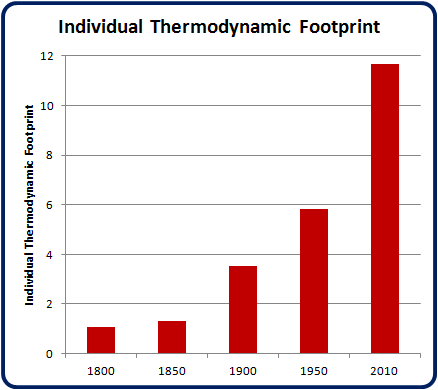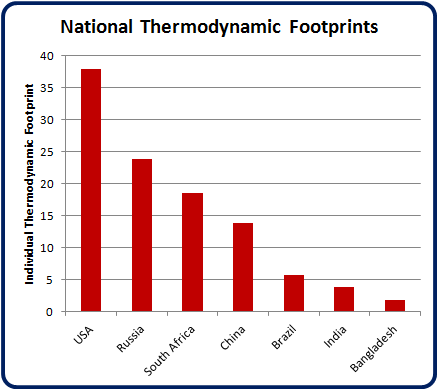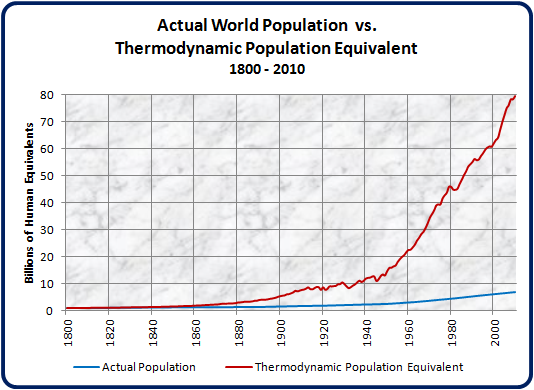
|
Mother Pelican
A Journal of Solidarity and Sustainability
Vol. 9, No. 4, April 2013
Luis T. Gutiérrez, Editor
|
|
|
|

|
|
|
Thermodynamic Footprint
Paul Chefurka
Approaching the Limits to Growth
This article was originally published in
Approaching the Limits to Growth, 12 March 2013
REPRINTED WITH PERMISSION
|
This article introduces the concept of the Thermodynamic Footprint or TF. At the end I briefly discuss a follow-on concept, a measure I call the Human Thermodynamic Equivalent or HTE.
|
This article introduces the concept of the Thermodynamic Footprint or TF. At
the end I briefly discuss a follow-on concept, a measure I call the Human Thermodynamic Equivalent or HTE.
This work has two purposes: to measure the impact we are
having on the planet, and to measure the change in our impact over
time. I believe that our energy use is the best
available proxy for the impact we are having on the planet because
energy is essential for all human activity. It is through energy
expenditure that we alter the planet's physical, biological and
chemical makeup - through mining, manufacturing, construction, habitat
alterations, and the generation of wastes such as carbon dioxide and
other
pollution.
Unlike the "carbon footprint"
that it may superficially resemble, the TF is really a measure of overall
human activity. By implication it measures our impact on the
environment, since all human
activity has some impact on the
planet. As a result it has quite a different intention than the
existing measures of carbon footprint
or ecological footprint.
This difference in intention has a direct bearing on discussions of our
growing population and
consumption.
Definition
The Thermodynamic Footprint is the ratio of all the energy a person
normally uses in their life, over just the
amount of energy they generate within their bodies from food. The
"energy we
normally use" includes food,
fossil fuels and non-fuel generated electricity
from hydro, nuclear and renewable power. It includes both our own
direct energy use and our individual share of all the energy society
uses to create and maintain the world we live in.
The result is a number that describes how many peoples' worth of
environmental impact an
individual creates. If someone uses no additional energy beyond food,
their TF value would be 1.0. If their TF is 2.0, it means that person
has twice the thermodynamic impact on their environment as an "unaided"
person. Someone with a TF of 10 has the same impact as ten
unaided people.
How
is the TF Calculated?
The TF calculation begins with the amount of
fuel-sourced CO2 produced
by one person in a day. This can be for an specific individual,
or an average per-capita share for a nation, or the world as a
whole. That number is divided by the ~1.4 kg/day of CO2 an
average
person working normally generates from burning food. That ratio is then
adjusted
upwards to account for any added use of hydro and nuclear
electricity,
since in the final analysis all
the extra energy we use creates environmental impact.
Some
Initial
Assumptions
The main assumption is that all energy use creates an environmental or
ecological impact. While we are used to thinking of the
impact of the energy sources themselves (for example, the CO2 and other
pollution from burning fossil fuels; radioactive contamination from
nuclear reactors; the mountaintop damage of coal mining; etc.) the
impact of energy goes far beyond those initial effects. Energy
enables all human activities,
from agriculture to city-building, from dredging waterways to digging
mines. Every human activity carries with it a web of direct and
indirect environmental impacts that are independent of the source of
energy used in the activity.
Using CO2 emissions from breathing and fuel use in this way requires
the following assumptions:
- The CO2 in our breath (endosomatic CO2 "from within the body") represents
the
basic thermodynamic state of one human being.
- The CO2 we generate by burning fossil fuels (exosomatic CO2 "from outside the body") can be
thought of as a mechanical extension of our breathing,
since it results in the same thermodynamic outcome: work.
- The generation of ~1.4 kg/day of exosomatic CO2 represents
a
similar amount of impact to the planet as one human being doing average
physical work. (Note that this
doesn't fully account for
the CO2 produced by the land use changes required for food production,
though our other
energy use swamps that effect today.)
- Exosomatic CO2 emissions from fuel use represent a
reasonable initial proxy for
all human planetary impact. This is because all our impact is
driven by energy, and 87% of our energy comes from fossil fuels.
What about
other forms of energy?
Humans were already using a substantial amount of exosomatic energy
well before 1800. Even before the discovery of agriculture some 8,000
years ago, our ancestors were already using firewood and other
biofuels, oxen, horses, donkeys, mules, yaks, dogs etc. to do some of
the work that had to be done. If we count all of the energy and
CO2 produced by biomass fuels and and draft animals, that would seem to
add quite a lot to the human footprint.
However, I deliberately omit these sources of energy and CO2 from the
calculation and focus solely on our use of stored energy sources.
I have several reasons for this decision.
- Those pre-industrial CO2 sources are all the direct result
of the real-time flows of energy that originate with photosynthesis -
whether directly in the case of biomass or indirectly in the case of
animals. As a result, the amount of work they can provide isn't a
major contributor to planetary damage - certainly not compared to our
drawdown of stored energy stocks such as fossil fuels.
- Humanity has always had animals and biomass as part of our
heritage. In the past we have generally employed them in direct
proportion to our numbers. I assume that even today their contribution
remains approximately proportional to our population. Where this
may not be so for modern humans, as with the expansion of our use of
food animals like cattle and pigs, that expansion is enabled by the use
of fossil fuels and electricity. As a result, the damage it represents
is already accounted for under the assessment of that energy.
- I am using the CO2 production of human beings as a baseline
for the minimal level of human activity. This approach allows a
simple comparison between unaided human activity and the activity that
has been enabled by our use of stored energy. Our use of stored energy
far outstrips any other work-producing factor in human society.
For example, the calculation for the year 1800 represents the human
human muscle power of approximately one billion people, with a small
addition for coal - the only stored energy source in use at the
time. 1800 marks the point when the human "energetic exoskeleton"
began to draw down the stored reserves of planetary energy in a big way.
Data
Sources
The datra sources are national CO2
and energy consumption data taken from the BP
Statistical Review of
World Energy 2012, as well as global carbon emissions going back to
1751 provided by the U.S. Department of Energy's Carbon Dioxide
Information Analysis Center.
Preliminary
Results
First, here is the Thermodynamic Footprint of a single "average" world
citizen at various times since 1800:

- In 1800 the average individual TF was just over 1, since
not much fossil fuel or electricity was in use yet.
- By 1900 the average TF was about 4, meaning that each
person had the same impact as four "unassisted" people.
- By 2010 the TF of an "average" world citizen was about 12.
- Each person alive today puts the same load on the planet as
12 people did 200 years ago.
The next graph compares the current individual Thermodynamic Footprints
for various nations:

- The average TF of an American is about 38, while that of an
average Bangladeshi is just under 2. There are no
big surprises there.
The next graph is probably the most interesting. By multiplying the
average global TF
figure by the world population, we can find the "Thermodynamic
Population Equivalent" of the world over
time. This value reflects both our increasing energy consumption
and our growing world
population. It is a measure of the increasing planetary impact of
the growth in our technology, activity and numbers.

- In 1800 the actual world population was just under 1
billion, and the "thermodynamic population" was just over a billion.
- By 2010, the world's numeric population was 6.85 billion,
while the "thermodynamic population"
had ballooned to the equivalent of 80 billion people.
Conclusion
This calculation demonstrates the amount of damage that our
technological activity is causing to the planet. This activity,
driven by the energy we use in our daily lives, causes as much damage
to the planetary systems we depend on as 80 billion people would if
they were living in their raw human state, as hunter-gatherers.
There is potentially much more to be discovered here, but one thing
jumps out at me immediately. TF seems like a very good proxy for the
elusive "AT" term in the infamous I=PAT equation. By using it
that way we can deduce that humanity
today is having about 80 times the impact on the planet that we
had 200 years ago.
We estimate that there were about 10 million people living on the
planet just before the invention of agriculture 8,000
years ago. Modern human civilization is today having about 8,000 times the impact on the planet
as did our ancestors of that time.
The
Human Thermodynamic Equivalent
This measure has some similarity to the concept of the "energy slave".
Each of us represents the operation of some quantity of exosomatic
energy within our environment. That energy repesents the work of
a number of "human equivalents". The number in question is
directly given by our Thermodynamic Footprint.
One Human Thermodynamic Equivalent or "HTE"
is represented by the production of 1.4 kg of CO2 per day, or
equivalently 140 watts of power, from exosomatic sources.
As
a sidebar, this definition allows us to verify the original TF
calculation in another way: by considering the amount of power
generated in the world from all sources. This is estimated to be
around 14 terawatts (with some imprecision due to the efficiency
differences of various fuel uses). If there are currently 7
billion people in the world, each producing an average of 140 watts,
the total power production of human bodies is about 1 terawatt.
Compared to the 14 terawatts of power consumed in the world today, this
gives an average individual TF of 14 - quite close to the value of 12
that was calculated above using global CO2 emissions and adjusting for
hydro and nuclear power production. the difference is progbably
due to the fact that the 14 TW estimate includes biomass power
production, while the TF does not.
There are about 80 billion Human Thermodynamic Equivalents at work in
the world today. We can get a feeling for what this means to the
planet if we look at the average human population density. This is estimated
at 50 people per square kilometer, or 135 per square mile, calculated
over the world's entire land area excluding Antarctica. If we
consider the HTE, however, the density changes to 600 per square
kilometer, or 1600 per square mile. This is similar to having the
population density of Taiwan living and working on each and every
square mile of land surface on the entire planet - including all the
plains, steppes, tundra, taiga, swamps, forests, deserts and mountain
ranges - except for Antarctica.
Of course, our activity is not spread out evenly across the planet.
Some areas have very little human activity, while others have quite a
lot. If we estimate that half of all the world's land is used by
humans in one way or another, this brings the average HTE density of
the areas that are subject to human impact up to 3200 human equivalents
per square mile. This is somewhat higher than the population
density of Bangladesh.
In the face of this degree of pressure, it is no wonder that our
activity is damaging the world's atmosphere, geology, water chemistry
and living ecology as profoundly as it is today. The 64 trillion
dollar question is, "How close are we to the point where the Earth's
systems can no longer cope with these changes, and finally force us to
cease and desist?"
ABOUT THE AUTHOR
Paul Chefurka is a Computer Scientist with a lifelong interest in environmental issues. He has spent over twenty years working in Research and Development in the Ottawa telecommunications industry, and is currently Project Manager at Canadian Coast Guard and the Canadian Department of Fisheries and Oceans. His personal web site, Approaching the Limits provides open access to his writings and is a valuable resource for study and reflection on many dimensions of the impending ecological crisis.
|
|Back to TITLE|
Page 1
Page 2
Page 3
Page 4
Page 5
Page 6
Page 7
Page 8
Page 9
Supplement 1
Supplement 2
Supplement 3
Supplement 4
Supplement 5
Supplement 6
PelicanWeb Home Page
|
|
|
|
"No power is strong enough to be lasting
if it labors under the weight of fear."
— Cicero
|
|
Page 3
|
|
FREE SUBSCRIPTION
|
![[groups_small]](groups_small.gif)
|
Subscribe to the
Mother Pelican Journal
via the Solidarity-Sustainability Group
Enter your email address:
|
|
|
|